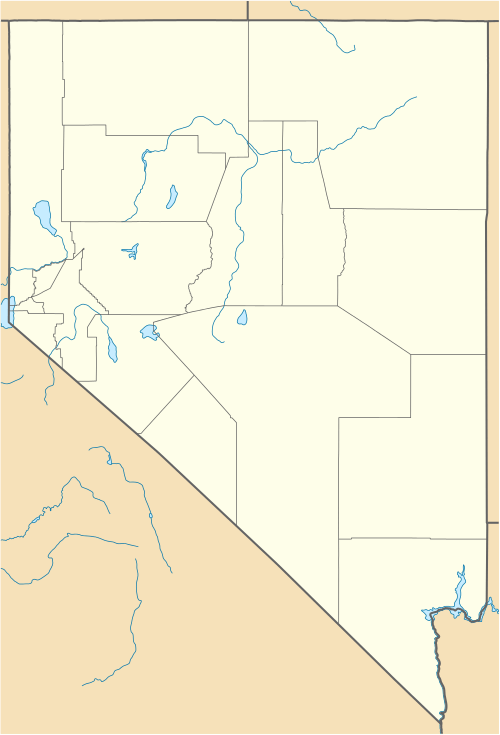Old Las Vegas Mormon Fort State Historic Park
|
Las Vegas Mormon Fort | |
|
Nevada Historical Marker #35 | |
|
Part of the reconstructed Las Vegas Mormon Fort | |
  | |
| Location |
500 Las Vegas Blvd. N. Las Vegas, Nevada |
|---|---|
| Coordinates | 36°10′50″N 115°8′01″W / 36.18056°N 115.13361°WCoordinates: 36°10′50″N 115°8′01″W / 36.18056°N 115.13361°W |
| Built | 1855 |
| NRHP Reference # |
72000764 (original) 78003379 (increase) |
| MARKER # | 35 |
| Significant dates | |
| Added to NRHP | February 1, 1972 |
| Boundary increase | December 12, 1978 |
Old Las Vegas Mormon State Historic Park is a state park of Nevada, USA, containing the Old Mormon Fort, the first structure built by people of European heritage in what would become Las Vegas fifty years later.
In present-day Las Vegas, the site is at the southeast corner of Las Vegas Boulevard and Washington Avenue, less than one mile north of the downtown area and Fremont Street. This is the only U.S. state park located in a city that houses the first building ever built in that city.[1]
A visitor center is available to help explain the history of the fort. The fort is listed on the National Register of Historic Places. The site is marked as Nevada Historical Marker #35.
History
Mormon missionaries arrived on June 14, 1855 and selected a site, along one of the creeks that flowed from the Las Vegas Springs, on which they would build the fort. The fort served as the midpoint on the trail from Salt Lake City, Utah and Los Angeles, California.
The fort was surrounded by 14-foot (4.3 m) high adobe walls that extended for 150 feet (46 m). While called a fort, it was never home to any military troops but like many Mormon forts provided a defense for the local settlers against an Indian attack. As a result of the beginning of the Utah War, the Mormons abandoned the fort.
Around 1860, a small detachment of U.S. Army troops was assigned to protect the settlers at the fort.
The fort was called Fort Baker during the Civil War, named after Edward Dickinson Baker. In a letter from Col. James Henry Carleton written to Pacific Department headquarters, December 23, 1861, Carleton mentions his plan to send an advance party of seven companies from Fort Yuma to reoccupy Fort Mojave and reestablish the ferry there.[2] Carleton then intended to send on from there three cavalry companies and one of infantry to the Mormon fort at Las Vegas, and establish a post called Fort Baker. This was in preparation for an advance to Salt Lake City the following year.[3] The move to reoccupy Fort Mojave never occurred as planned because Carleton's California Column at Fort Yuma were sent instead into Arizona and New Mexico to evict the Confederates there the next year. However, Fort Mojave was later reoccupied in 1863 by Union troops from California. In 1864, a road survey party led by Captain Price, Company M, 2nd California Cavalry traveled on the route from Fort Douglas to Fort Mojave passing through Las Vegas, stopping for water there on June 10. No mention is made of any garrison there.[4] Presumably the post was never garrisoned during the Civil War.
In 1865, Octavius Gass re-occupied the fort and started the irrigation works, renaming the area to Las Vegas Rancho. Gass defaulted on a loan to Archibald Stewart in 1881 and lost the ranch, with Stewart and his wife Helen becoming the new caretakers. In 1902, William A. Clark's San Pedro, Los Angeles, and Salt Lake Railroad acquired the property from Helen Stewart along with most of what is now downtown Las Vegas, transferring most of the company's land to the now defunct Las Vegas Land and Water Company.[5]
Ownership of the fort and the land around it changed hands many times and it had several close calls with destruction. In 1955, the land was acquired by the Las Vegas Elks. With support of the Daughters of Utah Pioneers, the city of Las Vegas acquired the fort in 1989. Long-term protection was gained when the state acquired the site as a state park in 1991.[6] A $4.5 million renovation was completed in 2005.
The building was listed on the National Register of Historic Places on February 1, 1972.[5] Additional land surrounding the building was listed on the National Register of Historic Places on December 12, 1978.[5]
See also
References
- ↑ The Smithsonian, guide to Historic America, The Desert states - page 318
- ↑ Carleton calls it Fort Navajo, but by referring to the ferry and Major Hoffman's route up the Colorado in his campaign against the Mohave Indians it clearly indicates he means Fort Mojave. He also indicates it will then draw supplies from Los Angeles. Fort Mojave was the terminus of the supply route known as the Mojave Road from San Bernardino and Los Angeles.
- ↑ California. Adjutant General's Office, Records of California men in the war of the rebellion 1861 to 1867, State office, 1890 p. 21
- ↑ Aurora Hunt, The Army of the Pacific: its operations in California, Texas, Arizona, New Mexico, Utah, Nevada, Oregon, Washington, Plains Region, Mexico, etc., 1860-1866, Stackpole Books, Mechanicsburg, 2004, pp. 202-203
- 1 2 3 "Nevada State Parks Old Las Vegas Mormon Fort Historic State Park pamphlet" (PDF). Retrieved 2011-01-30.
- ↑ Puit, Glenn (1997-12-14). "Living History". Las Vegas Review-Journal. Las Vegas, Nev. pp. 1B.
External links
| Wikimedia Commons has media related to Old Las Vegas Mormon Fort State Historic Park. |
- Old Las Vegas Mormon State Historic Park
- The Old Mormon Fort: Birthplace of Las Vegas, Nevada a National Park Service Teaching with Historic Places (TwHP) lesson plan
.jpg)